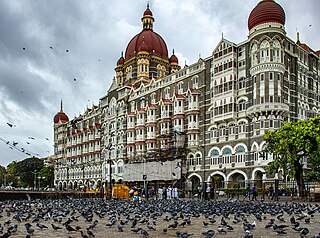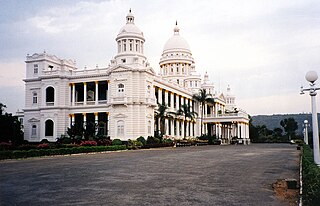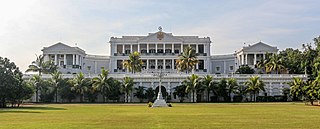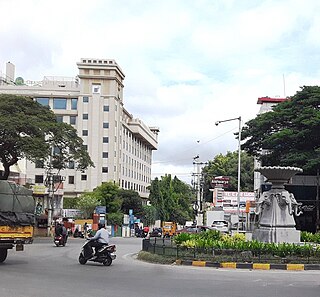
A palace is a grand residence, especially a royal residence, or the home of a head of state or some other high-ranking dignitary, such as a bishop or archbishop. The word is derived from the Latin name palātium, for Palatine Hill in Rome which housed the Imperial residences. Most European languages have a version of the term, and many use it for a wider range of buildings than English. In many parts of Europe, the equivalent term is also applied to large private houses in cities, especially of the aristocracy; often the term for a large country house is different. Many historic palaces are now put to other uses such as parliaments, museums, hotels, or office buildings. The word is also sometimes used to describe a lavishly ornate building used for public entertainment or exhibitions such as a movie palace.

Raj Bhavan, Karnataka is the official residence of the governor of Karnataka located in Bengaluru city, in the State of Karnataka, India. Constructed in the late 18th century. It formerly served as the official residence of the governor of Madras State.

Maharaja Chamarajendra Wadiyar X was the twenty-third maharaja of the Kingdom of Mysore, between 1868 and 1894.

The Mysore Palace, also known as Amba Vilas Palace, is a historical palace and the royal residence (house) at Mysore in the Indian state of Karnataka. It is used to be the official residence of the Wadiyar dynasty and the seat of the Kingdom of Mysore. The palace is in the centre of Mysore, and faces the Chamundi Hills eastward. Mysore is commonly described as the 'City of Palaces', and there are seven palaces including this one; however, 'Mysore Palace' or 'Amba Vilas Palace' refers specifically to the one within the Old fort.

The Taj Mahal Palace is a heritage, five-star, luxury hotel in the Colaba area of Mumbai, Maharashtra, India, situated next to the Gateway of India. Built in the Saracenic Revival style, it opened in 1903 as the Taj Mahal Hotel and has historically often been known simply as "The Taj". The hotel is named after the Taj Mahal, which is located in the city of Agra approximately 1,050 kilometres (650 mi) from Mumbai. It has been considered one of the finest hotels in the East since the time of the British Raj. The hotel was one of the main sites targeted in the 2008 Mumbai attacks.

The Bogor Palace is one of six Presidential Palaces of Indonesia, it is located in the city of Bogor, West Java. The palace is noted for its distinctive architectural and historical features, as well as the adjoining botanical gardens. Istana Bogor was opened to the public in 1968 to public tour groups, with the permission of the acting President of Indonesia, Suharto. The gardens of the palace covers an area of 284,000 square metres.

The Lalitha Mahal is the second largest palace in Mysore. It is located near the Chamundi Hills, east of the city of Mysore in the Indian state of Karnataka. The palace was built in 1921 at the orders of His Highness Krishnaraja Wodeyar IV, the Maharaja of Mysore for the exclusive stay of the Viceroy of India. Built on a raised ground, the palace was fashioned on the lines of the St Paul's Cathedral in London and is one of the imposing structures of the Mysore city.

Jaganmohan Palace is a palace in the city of Mysore, India. Its construction was completed in 1861 and was initially used by the Wodeyars, kings of Mysore as their home. It is now used as an art gallery and a function hall. The palace is one of the seven palaces of the royal city of Mysore.

The Rajendra Vilas is a palace-hotel atop Chamundi Hills in Mysore, Karnataka, India. It is now closed and in a state of neglect and can only be visited with prior permission.

Falaknuma is a palace in Hyderabad, Telangana, India. It originally belonged to the Paigah family, and was later owned by the Nizam of Hyderabad. It is on a hillock and covers a 13-hectare (32-acre) area in Falaknuma, 5 kilometres (3.1 mi) from Charminar.

Mysore is a city in the state of Karnataka, India. It is known as the cultural capital of Karnataka. Mysore was the capital of the Wodeyar kings who ruled over the Mysore Kingdom for many centuries. Wodeyars were great patrons of art and music and have contributed significantly to make Mysore a cultural centre. Mysore is well known for its palaces, museums and art galleries and the festivities that take place here during the period of Dasara attract a worldwide audience. Mysore has also lent its name to popular dishes like Mysore Masala Dosa and Mysore Pak. Mysore is also the origin of the popular silk sari known as Mysore silk sari and has also given rise to a popular form of painting known as Mysore painting.

Hill Palace is an archaeological museum and palace located in the Tripunithura neighbourhood of Kochi city in the Indian state of Kerala. It is the largest archeological museum in the state and was the imperial administrative office and official residence of the Cochin Maharaja. Built in 1865, the palace complex consists of 49 buildings in the traditional architectural style, spreading across 54 acres (220,000 m2). The complex has an archaeological museum, a heritage museum, a deer park, a pre-historic park and a children’s park. The campus of the museum is home to several rare species of medicinal plants. Presently the palace has been converted into a museum by The Kerala State Archaeology Department and is open to public. The palace is about 10 kilometres (6.2 mi) from the city centre and is approachable by road and rail.

Shiv Niwas Palace is a former residence of the Maharana of Udaipur, Rajasthan, located on the banks of Lake Pichola.

Kanakakkunnu Palace is situated in Thiruvananthapuram near the Napier museum, India. It is India's first digital garden, created by Akhilesh S. V. Nair and A. Gangaprasad, University of Kerala, Department of Botany.
Bangalore Munivenkatappa was a building contractor in the pre-independence era of Indian history. He was born on 12 August 1888 and was majorly based in the Karnataka state. He built many prominent landmarks in his time. He was also involved in the construction of the Mysore Palace. The British honored him with the title of 'Rao Sahib' in 1937.

Kote Venkataramana Temple is a Hindu temple in Krishnarajendra Road, Bangalore, India dedicated to the god Venkateshwara. The temple was built in 1689 in Dravidian and Vijayanagara style by King Chikka Devaraja Wodeyar, then ruler of Mysore.

Sayaji Rao Road, also known as Sayyajirao Road is a road in Mysore, India. It runs North from Agrahara circle at one end to Highway circle at the other.
Agrahara is one of the suburbs of Mysore in the state of Karnataka in India.
















